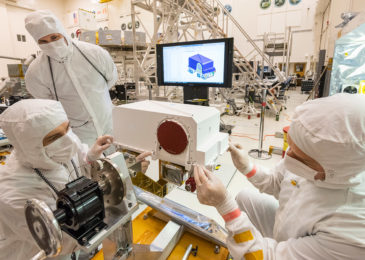
NASA’s Curiosity wanderer has been a crushing accomplishment since its arrival on Mars in 2012. Along these lines, it’s nothing unexpected the up and coming Mars 2020 wanderer will utilize a fundamentally the same as plan. The group is as of now gathering the meanderer, which is planned for a July 2020 dispatch, and it just got two of its most significant segments: the Mastcam-Z cameras. These superior quality, zoom-competent cameras will enable NASA to study the Martian scene and produce the photographs that will no uncertainty wow everybody back here on Earth.
In the picture above, you can see colleagues re-introducing the spread on the remote detecting pole (RSM) subsequent to mounting the cameras. The RSM is home to various instruments and cameras simply like it was on Curiosity — you could think about this as the wanderer’s “head.” The meanderer will have a sum of 23 cameras when it’s finished.

The enormous red focal point spread is the SuperCam, an arrangement of lasers and spectrometers that can break down the concoction organization of rocks. It’s an updated form of Curiosity’s ChemCam. Legitimately south of that is one of the meanderer’s two Mastcam-Z units. The other is mostly darkened by help gear in the frontal area. Both Mastcam-Z modules have spreads marked “expel before flight.”
Cooperating, the two 1600×1200 Mastcam-Z units will probably take full-shading 3D pictures of the Martian scene. These cameras share a lot with Curiosity’s Mastcams including body structure, indicators, and firmware. Notwithstanding, they have coordinated 3.6:1 optical zoom capacity. The Mastcam-Z framework has a goals of 0.8mm per pixel just before the meanderer and 38mm per pixel 100 meters away. NASA anticipates that this should make the group’s driving and test gathering exercises a lot simpler than they are with Curiosity.
NASA right now gets ready for a February 21, 2021 arriving on Mars. This meanderer will be the primary shuttle in the historical backdrop of planetary investigation that is equipped for dissecting and retargeting its arrival consequently. It will likewise send the primary consistently flying vehicle on another planet, the Mars Helicopter Scout. Mars 2020 has a normal mission span of one Martian year, however in the event that it’s in any way similar to Curiosity, it’ll last any longer. Indeed, even after the meanderer closes down, it might at present have the option to add to science by putting away examples in an extraordinary module for later gathering by an up ’til now spontaneous example return mission.
Disclaimer: The views, suggestions, and opinions expressed here are the sole responsibility of the experts. No Opinion Bulletin journalist was involved in the writing and production of this article.



